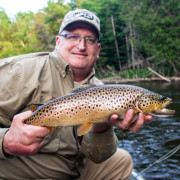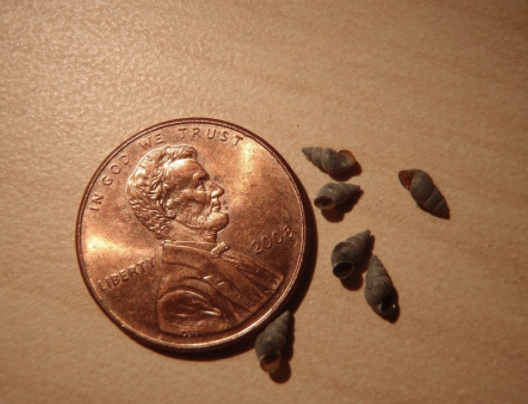Pic of the Day – Underwater Mouse Eater
Photo by Ed McCoy of a Michigan Brown Trout snacking on one of his new mouse patterns. Thanks for sharing the pic Ed. Nice work.
Photo by Ed McCoy of a Michigan Brown Trout snacking on one of his new mouse patterns. Thanks for sharing the pic Ed. Nice work.
A post shared by Mangledfly (@mangledfly) on
 If Michigan’s government wanted to send over 200,000,000 gallons of our precious spring water to another part of the country would you be for that? What if that water was coming from a key aquifer that feeds the Muskegon river system? That’s exactly what Nestle would like to do. A current proposal under consideration by the Michigan Department of Environmental Quality (DEQ) is requesting “a large quantity increase” in extraction from the company’s Evart, Michigan facility. In case you’re wondering what a “large quantity” is, Nestle is seeking a nearly 300% increase in the volume of water it extracts (Source: Detroit Free Press). If the Southwest were trying to take our water to alleviate drought, there would be public outrage. But if you want to come in and extract it into 16 ounce bottles – SURE, c’mon in! Oh, and the cost to Nestle for this? Only $200. Yep, you read that right.
If Michigan’s government wanted to send over 200,000,000 gallons of our precious spring water to another part of the country would you be for that? What if that water was coming from a key aquifer that feeds the Muskegon river system? That’s exactly what Nestle would like to do. A current proposal under consideration by the Michigan Department of Environmental Quality (DEQ) is requesting “a large quantity increase” in extraction from the company’s Evart, Michigan facility. In case you’re wondering what a “large quantity” is, Nestle is seeking a nearly 300% increase in the volume of water it extracts (Source: Detroit Free Press). If the Southwest were trying to take our water to alleviate drought, there would be public outrage. But if you want to come in and extract it into 16 ounce bottles – SURE, c’mon in! Oh, and the cost to Nestle for this? Only $200. Yep, you read that right.
The DEQ has said studies show that the aquifer can more than support this increase. Although it did so after deciding to overrule the computer model that said that this withdrawal could adversely effect the Muskegon river watershed (Source: Mlive). Not to mention that Nestle’s chief spokesperson, Deb Muchmore is married to Governor Rick Snyder’s former Chief of Staff (who is now a registered lobbyist). Smell funny to you?
Normally, we stay out of politics here on Mangled Fly, but this one’s important. This is an issue that impacts anyone who fishes or enjoys our rivers. The Muskegon is Michigan’s longest river, and holds trophy steelhead, trout, smallmouth bass, and much more. It’s time we stood up to Nestle, and its insider trading with our State government. And you have a chance to do exactly that.
First, please send an e-mail to the Michigan DEQ voicing your opposition to this proposal (details here). E-mail can be addressed to: deq-eh@michigan.gov. Be outraged. Be logical. Be candid. But please take the time to weigh in on this issue. Protect Michigan’s waters, both for today and for future generations.
Beyond this, please consider voting with your wallet. Did you know that in 2107 for the first time bottled water consumption is expected to exceed soda consumption? According to Beverage Marketing, via USA Today, in early 2017 this will happen. We suggest not buying bottled water from any of Nestle’s 300 brands (complete list here). Beyond that, consider your consumption of any bottled water. Sure, sometimes it’s convenient, but purchasing a water bottle or two and refilling from the tap reduces demand. And, without demand, Nestle will turn its attention elsewhere.
So those that fish with me know that I have a few superstition’s. 1 – NO BANANA’S 2- No white lighters . Bring either of these items in the boat and you will get some sort of negative reaction. #grumpyguide.
Also my wife has been known to laugh at me, as I tend to wear certain clothing items when I’m guiding and not others. Based on past success when wearing these certain clothing items. With that I have lucky hats that I will continue to wear when fishing is good. And No Way do we wash these hats, can’t clean out the good luck! No matter how bad they start to stink! With that, one thing I’ve noticed this year, is that clients wearing the Digital Camo Cap in my boat this month have scored some nice trout.
So can it be true that the Digital Camo Cap can help you score a trout over 20″? Proof might be in the pudding. I know if I didn’t have one yet, I would get one before they are gone.
I have no affiliation with the people who make a certain product, but I have to say that some of their stuff is brilliant. The product that I am speaking of is ice dub, and between ice dub and the various colors of flashabou, I could guide every day with little else than thread and hook (though I do like some feathers and fur too:)). During the months of January-March, I rely very heavily on one color family of ice dub. The colors are olive, peacock-eye, peacock, and black peacock. These colors seem to imitate the same things to the fish. It could be that the sheen on this color scheme is just plain appealing to fish (it is an attractor color). On the other hand, it could be that many of the bait fish in the river take on a peacockish tint during the winter months.
When I started looking underwater in the winter, I was surprised at just how many creatures had a bluish/green tint in the winter months. The darter above is just one example of this color scheme in nature during the winter and spring. Crayfish, scuds, gobies, and other fish also have this peacock overtone to their colors.
Whether it is just naturally attractive, or whether it is due to the colors occurring in nature, or some combination of the two, I am not entirely certain. At the end of the day, these colors of ice dub just work great for catching predator fish.
Through the first half of the year, flies with this color scheme can be fished in several different ways. They can be swung on sink tips through flat runs during the winter months for steelhead. Another option is to fish the soft edges of the stream for resident trout with smaller olive or peacock based flies. I really enjoy swinging wet flies for trout and this is a great extension of wet fly fishing through the winter months. Yet another option is to tie weighted sculpins and fish them below an indicator for trout. Often times a nymph pattern is fished on a dropper between the indicator and the weighted sculpin.
This post mentions the months of January through May. However, as a guide, these colors are in my box year around, no matter what species I am guiding for. Give this color family a shot on your local stream. I am pretty sure that it will work!
Thanks for reading this!
 If you haven’t heard their is a new invasive species in the Michigan waters, the Mud Snail. In the past two days two new articles have been written about stopping the spread of the Mud Snail. Links are below. Please wash your waders, wading boots, boats and trailers if you plan on fishing different waters this spring and summer.
If you haven’t heard their is a new invasive species in the Michigan waters, the Mud Snail. In the past two days two new articles have been written about stopping the spread of the Mud Snail. Links are below. Please wash your waders, wading boots, boats and trailers if you plan on fishing different waters this spring and summer.
I’m honored to have Patagonia Flyfishing post an image on their Instagram account , thank you Larry and Paul for letting me take a minute and play as we floated a Michigan trout stream this fall.
Be on your way now, see you again! Photo @mangledfly @patagonia @patagoniaprovisions
A photo posted by Patagonia Fly Fish (@patagonia_flyfish) on
September is gateway to the fall, and it has become my favorite month to fish. After a busy summer with the smallmouth, I take some time to relax and fish. I thought I would share two experiences, which were radically different in some ways but completely the same.
Last week, I visited muskie land for a chance at a big fish. They are one of my favorite recreational species. I was fishing alone and it was extremely windy, so fishing was uber challenging in this vast, open area. After two solid mornings, several fish had followed my shiny flies to the boat, but no connection. I was beginning to wonder if I would ever catch one. After numerous casts, zilch. I texted with Jon Ray and he said “chartreuse”. I took his suggestion. Literally on the first cast, I caught the glimpse of something beneath my fly. Soon the shadow disappeared, but something told me not to rush pulling the fly out of the water. I did a figure eight with my rod tip. I had never caught a musky with a figure eight, and my expectations were low. On the beginning of the second figure eight, a wide bodied fish exploded after my fly from under the boat. Soon he was hooked! It was one of the most exciting strikes I have ever had for any species. The fish was landed–it was a good sized fish, not huge, at 36″ in length.
Upon returning home, there was some time set aside to prepare for the fall season. In addition, I was hoping to accomplish one other fishing goal, to catch a brook trout in its fall spawning colors. There are numerous small creeks with brook trout in my area–in fact there is one in my back yard–so you think that this would be an easy task. This was not the case. I went to a stretch of a local small stream that is rumored to be great for brook trout. On the first day, I had several fish rise to my hopper pattern, but was unable to connect. Suddenly, a nice trout rose to my fly as it fell out of the grass on the bank. Much to my chagrin, my glee turned to horror. Normally I love brown trout, in this case I was disappointed with the 13 inch butterball on my line. I caught one more brown trout that day. The next morning, four browns as well as two rainbows we caught, but still no brookie. Finally, while swinging a wet fly, a tug registered on the line. I was frustrated when the fish was missed. The process was repeated, and again the fish took. I missed him yet again! I surmised that this must be a brook trout, as a brown trout would never be this stupid. On the third cast, I watched this nice trout follow my wet fly and it took. After a brief struggle, an 11″ jewel was at my feet. This moment was just as thrilling as catching the musky.
Fishing is always fun. Challenging fish make it more rewarding. This sounds like something a guide would say but the fish that you work for really are the most memorable. During the month of September, there are many challenges for the willing angler. Whatever fish you prefer to catch, get out and enjoy this great time of the year!
The DEQ has announced that it has found two new invasive species in Michigan rivers. The Pere Marquette River near Ludington has New Zealand mud snails and the St Mary’s river has didymo (rock snot). Read the announcement here, by the DEQ. Both of these species are very harmful to our rivers and the fish we pursue.
To stop further spread of these invaders wash all of your equipment thoroughly, including your warders, boots and boats after getting out of the water is mandatory. We all fish multiple rivers, we need to be vigilant to keep the remaining waterways free of these pests. Cleaning wading boots and waders is key to stopping the spread of invasive species.
Waders and Wading Boots – should be dried inside and outside throughly. This is especially important during the summer months when perspiration may build up in waders even with gore-tex and other breathable fabrics.
Clean off any mud, sand or other fine debris before leaving your stream or lake. This is especially important if you are fishing a stream or lake infected with rock snot AKA Didymo, zebra mussels or New Zealand mud snails. Use fresh water if you have enough to do this. Otherwise using the stream or lake water you are fishing in will help to keep the critters where they started.
A good stiff vegetable brush will clean off mud and debris off the soles, welts and other parts of wading boots and the soles of waders.
Allowing boots and waders to dry in the sun will help damage invasive species. On waders make sure to dry the outside, then turn the gravel guards up so they will dry under them.
Build a simple but effective wader drying station by purchasing a four post prebuilt type hat rack at Lowes or Home depot. Attach it to the wall studs with a 2 inch screw in each end. Hang the waders by the suspenders with an open post between to allow the waders to drape open a bit. My station holds the waders about 2 inches above the floor.
Allowing waders to dry throughly between uses will generally kill the common aquatic invasive species. The suggestion is to dry for 5 days minimum between fishing trips.
Wading boots should be laid out to drain and dry completely between uses if possible. This is especially important with felt soles. Beginning in 2011, all major wading boot manufacturers will no longer offer felt soles. Sticky Rubber, Aqua Stealth, soft rubber Vibram soles, Eco-Trax soles are a few of the substitues on the market.
Other Methods
- Soak your waders and boots in hot water over 120 degrees for at least 30 minutes will help to kill most invasive species.
- A combination of hot water and salt solution can also be used. See Controlling the spread of invasive species for the mixtures.
- 100% vinegar is an alternative to salt.
- Do Not use 409. It will eat your waders, is hard on the environment and is illegal too.
- Use a high pressure sprayer to clean wader soles and the cracks and crevices inside and outside the boots will help. Then soak in a hot water bath.
- I scrub my boots and waders in a hot water bath to remove the left over mud, stream debris, etc. and allow to completey air dry before using again.
Take the Clean Angling Pledge and follow it.
If we want to continue to have some the best fishing in the United States we are going to have to stay on this. Please tell your friends and fellow fishermen about this problem and be part of the solution!
